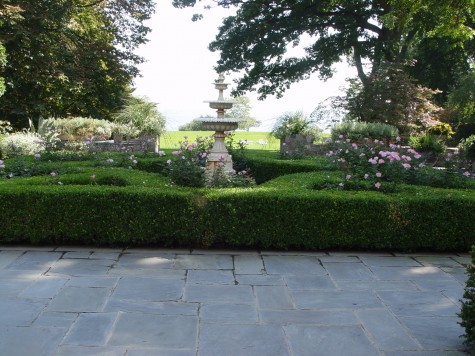 I have clients whose interest in gardens runs to green, and more green. Though my love for the green of the plant is every bit as great as my love for their flowers, I have never had the discipline it takes to restrict my own palette like this. But I find that whenever a client represents their own point of view outdoors, the result looks just right.
I have clients whose interest in gardens runs to green, and more green. Though my love for the green of the plant is every bit as great as my love for their flowers, I have never had the discipline it takes to restrict my own palette like this. But I find that whenever a client represents their own point of view outdoors, the result looks just right.
 These large stone and brick piers punctuate a pair of walls that partially enclose a terrace. I plant them with a mix of plants whose textures are as unlike stone and brick as possible. This is a matter of directing visual attention. The window boxes on the roof of my shop are not so gorgeous. They are made of galvanized sheet metal ordinarily used in the production of ductwork for the heating and cooling industry. The sole function of those boxes is to hold the soil, nutrients and water for the plants-they have no visual interest in and of themselves. The intent here is to acknowledge the beautiful surface of the container as much as the planting.
These large stone and brick piers punctuate a pair of walls that partially enclose a terrace. I plant them with a mix of plants whose textures are as unlike stone and brick as possible. This is a matter of directing visual attention. The window boxes on the roof of my shop are not so gorgeous. They are made of galvanized sheet metal ordinarily used in the production of ductwork for the heating and cooling industry. The sole function of those boxes is to hold the soil, nutrients and water for the plants-they have no visual interest in and of themselves. The intent here is to acknowledge the beautiful surface of the container as much as the planting.
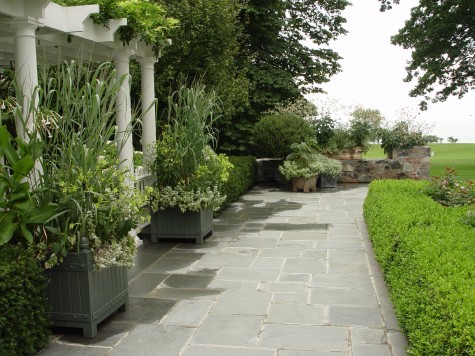 A green planting has a quiet and serene look, as the greens so closely relate in color and value. The green of these painted Belgian oak boxes harmonizes with the color of the bluestone terrace; the relationship is a subtle one. The Dallas Blues panic grass repeats that color. Monochromatic color schemes tend to read that way, although an ocean of orange is anything but serene. Add some contrasting purple to that orange, which in turn contrasts with the green, and you have a visual party going on. These greens speak softly.
A green planting has a quiet and serene look, as the greens so closely relate in color and value. The green of these painted Belgian oak boxes harmonizes with the color of the bluestone terrace; the relationship is a subtle one. The Dallas Blues panic grass repeats that color. Monochromatic color schemes tend to read that way, although an ocean of orange is anything but serene. Add some contrasting purple to that orange, which in turn contrasts with the green, and you have a visual party going on. These greens speak softly.
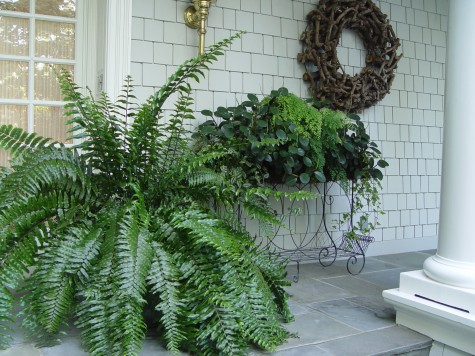 A porch planting plays the spiky texture of a tropical fern off the round chubby leaves of a of large scale pepperomia; the effect is pleasing, not demanding. The elegant English wirework planter reminiscent of vintage conservatory furniture is balanced with a simple and very rustic wreath that hangs on the wall year round.
A porch planting plays the spiky texture of a tropical fern off the round chubby leaves of a of large scale pepperomia; the effect is pleasing, not demanding. The elegant English wirework planter reminiscent of vintage conservatory furniture is balanced with a simple and very rustic wreath that hangs on the wall year round.
 The container collection is a beautiful one. An American stoneware grape panel container from the 1920’s, and English lead and the Belgian oak box are very different in materials and forms, but very much alike in feeling.
The container collection is a beautiful one. An American stoneware grape panel container from the 1920’s, and English lead and the Belgian oak box are very different in materials and forms, but very much alike in feeling.
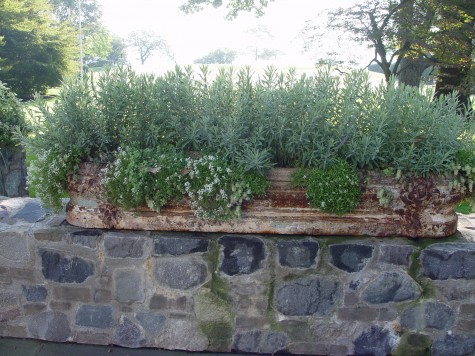 A pair of very old and distinctive French iron planters sit on the walls. I usually plant them with lavender, and alyssum, showy oregano, and whatever other herb like plant seems appropriate. The effect is graceful; the muted colors of every aspect of this space invite contemplation.
A pair of very old and distinctive French iron planters sit on the walls. I usually plant them with lavender, and alyssum, showy oregano, and whatever other herb like plant seems appropriate. The effect is graceful; the muted colors of every aspect of this space invite contemplation.
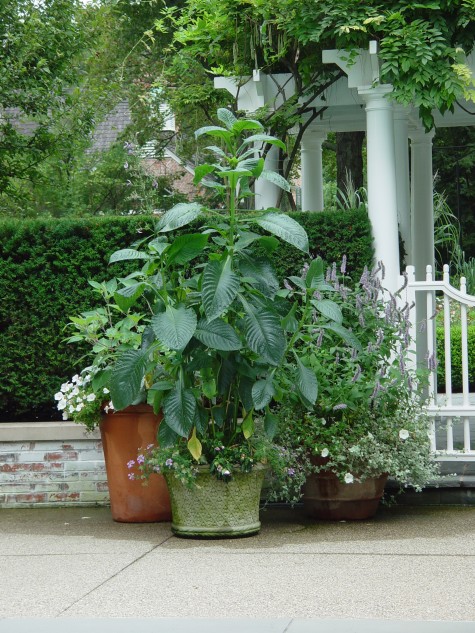 Some plants stay green all season, as our summer is too short to permit flowering-as in this large tropical salvia. The fine perennial hyssop hangs on to the ghostly lavender of its flowers a very long time; this is repeated in a lavender trailing verbena. Though there is some color here, it is the relationships of the greens that reads first and foremost.
Some plants stay green all season, as our summer is too short to permit flowering-as in this large tropical salvia. The fine perennial hyssop hangs on to the ghostly lavender of its flowers a very long time; this is repeated in a lavender trailing verbena. Though there is some color here, it is the relationships of the greens that reads first and foremost.
 I think the leaves of tibouchina grandiflora are surely my favorite. The large oval leaves are completely covered in fine white hairs; they are a marvel. Their contrast to the needles of the rosemary topiary is considerable in form, and little in color. Variegated licorice is one of the most versatile of all green plants. The leaves sport two different shades of green; the blotches are very blue green, while the edges are more yellow-green. It works with every plant with which it is paired. This collection of pots benefits from the lively effect of its habit of growth, and relative lightness. Subtle does not mean sleepy.
I think the leaves of tibouchina grandiflora are surely my favorite. The large oval leaves are completely covered in fine white hairs; they are a marvel. Their contrast to the needles of the rosemary topiary is considerable in form, and little in color. Variegated licorice is one of the most versatile of all green plants. The leaves sport two different shades of green; the blotches are very blue green, while the edges are more yellow-green. It works with every plant with which it is paired. This collection of pots benefits from the lively effect of its habit of growth, and relative lightness. Subtle does not mean sleepy.
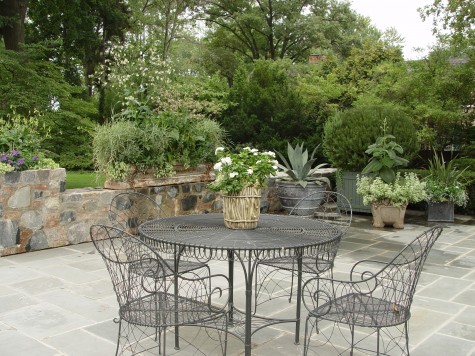
No one element here dominates a supporting cast. Each element has its own voice, but the close relationship of the voices makes for a space that whispers. Some gardens provide refuge from noise; this I like.
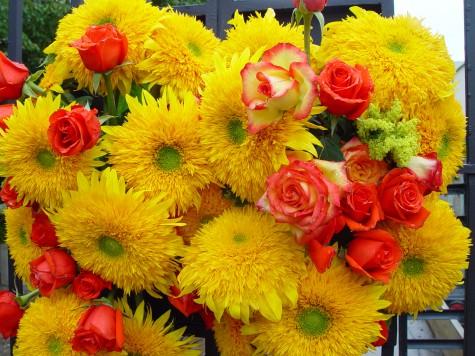 As my clients were bound and determined that Allie, Snoopy and Vladdy would be members of their wedding party, their choices for a wedding venue were slim to none. I was happy for them to get married at the shop, and equally happy to welcome the canine members of their family. Since the decision was made some six months prior to the ceremony, I had the chance to plan a garden that would look great on their late, late summer date.
As my clients were bound and determined that Allie, Snoopy and Vladdy would be members of their wedding party, their choices for a wedding venue were slim to none. I was happy for them to get married at the shop, and equally happy to welcome the canine members of their family. Since the decision was made some six months prior to the ceremony, I had the chance to plan a garden that would look great on their late, late summer date.  A copper pergola would provide the chuppah necessary for the ceremony. We infilled the poles at each corner with birch bark tubes. This blue and white scheme dictated the selection of plants as much as the season would. A collection of Italian cypress, giant rosemary topiaries, kales and cabbages would look swell come wedding time. Luckily a local grower has a very late batch of sunflowers, including the ultra double “teddy bear”. That intense yellow would warm up the arbor in a happy and sunny way. A goldenrod garland casually draped over the chuppah provided the roof necessary for the ceremony.
A copper pergola would provide the chuppah necessary for the ceremony. We infilled the poles at each corner with birch bark tubes. This blue and white scheme dictated the selection of plants as much as the season would. A collection of Italian cypress, giant rosemary topiaries, kales and cabbages would look swell come wedding time. Luckily a local grower has a very late batch of sunflowers, including the ultra double “teddy bear”. That intense yellow would warm up the arbor in a happy and sunny way. A goldenrod garland casually draped over the chuppah provided the roof necessary for the ceremony.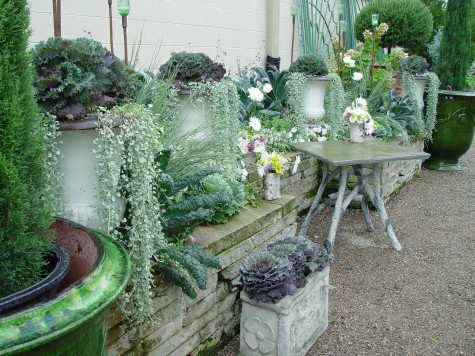 Silver dichondra has a distinctly blue cast; its diminuitive felted leaves were a great contrast to the giant blistered kale, “Nero di Toscano”. Short blue foliaged fescues, white million bells and showy oregano made good companions for the massive cabbages. White iron urns showed off the long tails of dichondra to good advantage.
Silver dichondra has a distinctly blue cast; its diminuitive felted leaves were a great contrast to the giant blistered kale, “Nero di Toscano”. Short blue foliaged fescues, white million bells and showy oregano made good companions for the massive cabbages. White iron urns showed off the long tails of dichondra to good advantage. As the ceremony required a table be available for the Rabbi, my clients chose a carved concrete faux bois piece whose legs were carved and acid stained to look like birch. The wedding party flowers in lime green, white, and lavender repeated the color scheme of the garden. Is that old rosemary topiary not a dream come true?
As the ceremony required a table be available for the Rabbi, my clients chose a carved concrete faux bois piece whose legs were carved and acid stained to look like birch. The wedding party flowers in lime green, white, and lavender repeated the color scheme of the garden. Is that old rosemary topiary not a dream come true?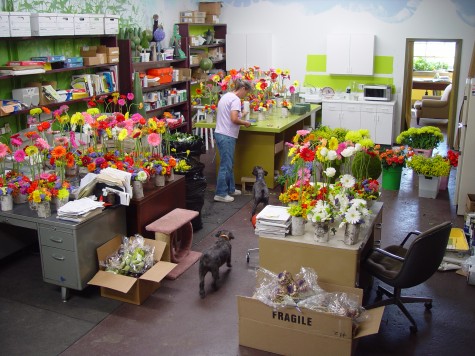 The plan for the reception involved nine 8′ long tables set end to end in the drive. Small glass vases covered in short birch bark tubes held late summer garden flowers available from the growers at my local farmer’s market. These 45 small arrangements centered on the tables would run for the entire 72 foot long reception dinner table.
The plan for the reception involved nine 8′ long tables set end to end in the drive. Small glass vases covered in short birch bark tubes held late summer garden flowers available from the growers at my local farmer’s market. These 45 small arrangements centered on the tables would run for the entire 72 foot long reception dinner table.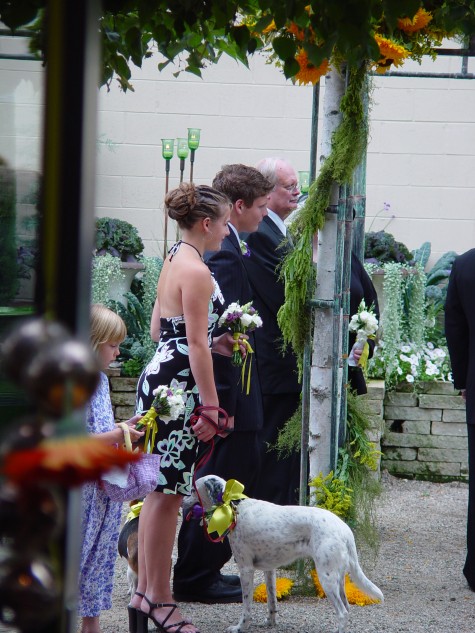 Allie and Snoopy were nervous, but they did take their big lime green satin bow and flower collars in stride. They did mill around-but just a little bit. All in all they were very well behaved.
Allie and Snoopy were nervous, but they did take their big lime green satin bow and flower collars in stride. They did mill around-but just a little bit. All in all they were very well behaved.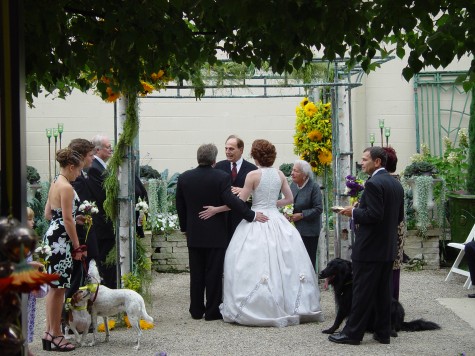 Vladdy was ordinarily fairly dignified and unflappable; he sat calmly through the entire ceremony.
Vladdy was ordinarily fairly dignified and unflappable; he sat calmly through the entire ceremony. 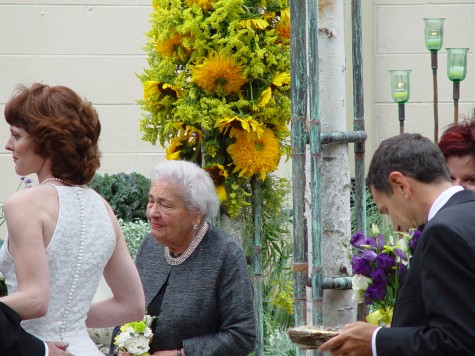 It was a beautiful wedding, and I was happy to have a part in it. There is something so satisfying about a small ceremony for everyone involved. When there are but a few details, every detail can be very personal and thoughtful. I think they were so pleased to be able to have their dog family there that day.
It was a beautiful wedding, and I was happy to have a part in it. There is something so satisfying about a small ceremony for everyone involved. When there are but a few details, every detail can be very personal and thoughtful. I think they were so pleased to be able to have their dog family there that day.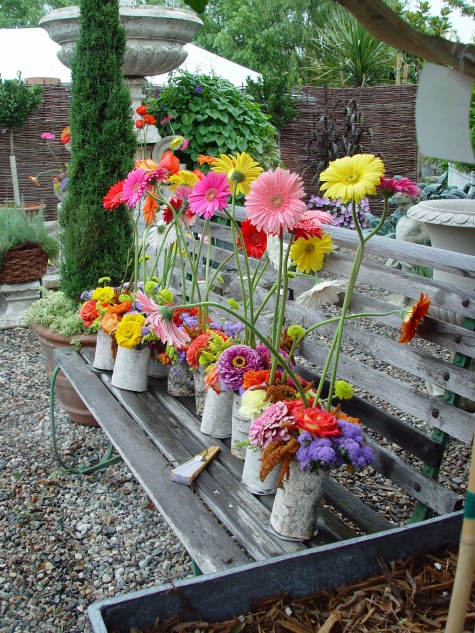
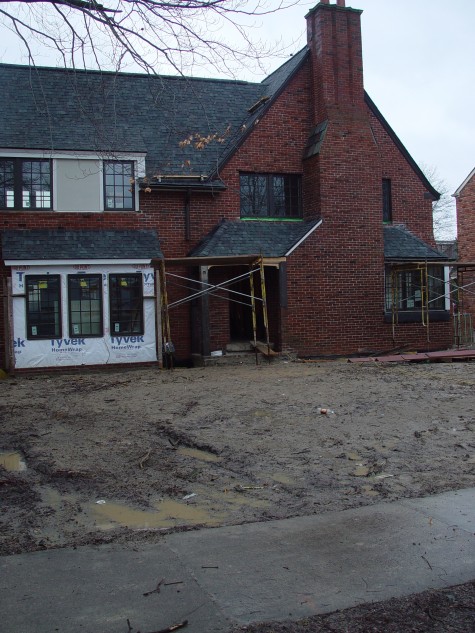 This lovely home in a local neighborhood was in sore need of updating, and needed additional space to house a young family with children. The addition was in progress the first time I saw the house. On this miserably wet and cold March day, the prospects for the outdoors did not look promising. Contractors had driven machines over every inch of land they owned. Water was sitting on the surface of the soil everywhere. It seemed like every move my clients made uncovered a new problem requiring attention. When a house is under major renovation, the landscape is last in line-as it needs to be.
This lovely home in a local neighborhood was in sore need of updating, and needed additional space to house a young family with children. The addition was in progress the first time I saw the house. On this miserably wet and cold March day, the prospects for the outdoors did not look promising. Contractors had driven machines over every inch of land they owned. Water was sitting on the surface of the soil everywhere. It seemed like every move my clients made uncovered a new problem requiring attention. When a house is under major renovation, the landscape is last in line-as it needs to be. 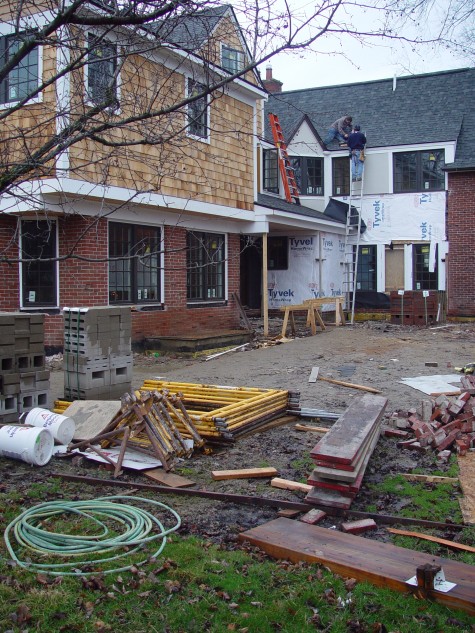 It wouldn’t be possible to install a landscape at this point. Some years ago the New York Times ran a feature about landscape costs-the thrust of which was that it can, and frequently does take as much money to build and furnish a landscape as a house. I don’t know that I would go that far, but a landscape is a considerable investment. Though property values have been under siege in our area of late, it is still true that for most people, their home will be the biggest investment they ever make-for better, or for worse. Thus I have no problem recommending to a young family that they invest such that fifteen years later, should they decide to move, a landscape that is in place will make that home they want to sell look settled, finished- irresistible.
It wouldn’t be possible to install a landscape at this point. Some years ago the New York Times ran a feature about landscape costs-the thrust of which was that it can, and frequently does take as much money to build and furnish a landscape as a house. I don’t know that I would go that far, but a landscape is a considerable investment. Though property values have been under siege in our area of late, it is still true that for most people, their home will be the biggest investment they ever make-for better, or for worse. Thus I have no problem recommending to a young family that they invest such that fifteen years later, should they decide to move, a landscape that is in place will make that home they want to sell look settled, finished- irresistible. 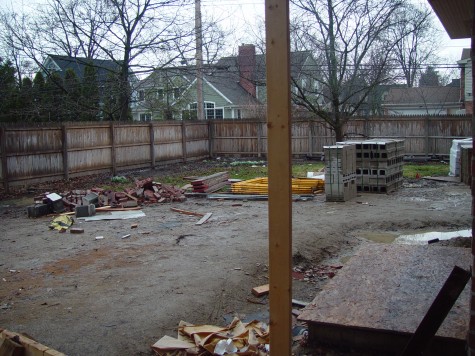 Some very important investments in a landscape are not fun. This property was the lowest property in the neighborhood, and water would stand and not drain for weeks after a heavy rain. The regrading and drainage work necessary to correct this problem was very expensive, and not so satisfying. It was about as much fun as buying a new hot water heater. I have seen many landscapes, installed both by home owners, and professional landscape contractors, where drainage issues were not addressed. The plant material is struggling, dying or dead from the lack of an investment in the drainage. For the sake of the future, some things cannot be skipped over.
Some very important investments in a landscape are not fun. This property was the lowest property in the neighborhood, and water would stand and not drain for weeks after a heavy rain. The regrading and drainage work necessary to correct this problem was very expensive, and not so satisfying. It was about as much fun as buying a new hot water heater. I have seen many landscapes, installed both by home owners, and professional landscape contractors, where drainage issues were not addressed. The plant material is struggling, dying or dead from the lack of an investment in the drainage. For the sake of the future, some things cannot be skipped over.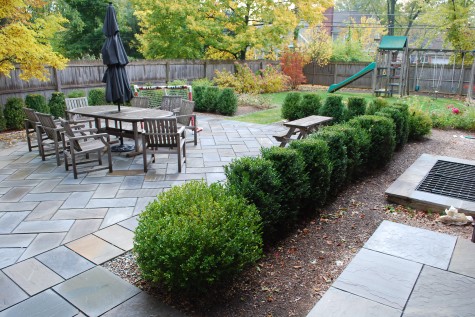 These clients knew they wanted stone for their terrace and walkways. Bluestone is a gorgeous natural stone that gives a space a solid and serious look. They also wanted their stone wet set in mortar. Mortaring stone to a concrete substrate insures a level surface that presumably does not move, or require maintenance. I say this with one caveat; the winters in Michigan will heave up just about anything. I made sure the installation was expert.
These clients knew they wanted stone for their terrace and walkways. Bluestone is a gorgeous natural stone that gives a space a solid and serious look. They also wanted their stone wet set in mortar. Mortaring stone to a concrete substrate insures a level surface that presumably does not move, or require maintenance. I say this with one caveat; the winters in Michigan will heave up just about anything. I made sure the installation was expert. Their decision was to stage the installation of the landscape such that they could have their mortared stone. The first year, their yard consisted of stone, and lawn. Year two saw the boxwood installed in the rear, and the yews in the front. This year, some of the garden. Next year, the yews designed to back up the boxwood here, and maybe an arbor. I do admire their willingness to wait, in order to have the landscape they wanted. Get a plan, pick a part to install you can handle, do it, and proceed again when time and money permits. This seems like such a logical and good way to proceed.
Their decision was to stage the installation of the landscape such that they could have their mortared stone. The first year, their yard consisted of stone, and lawn. Year two saw the boxwood installed in the rear, and the yews in the front. This year, some of the garden. Next year, the yews designed to back up the boxwood here, and maybe an arbor. I do admire their willingness to wait, in order to have the landscape they wanted. Get a plan, pick a part to install you can handle, do it, and proceed again when time and money permits. This seems like such a logical and good way to proceed. 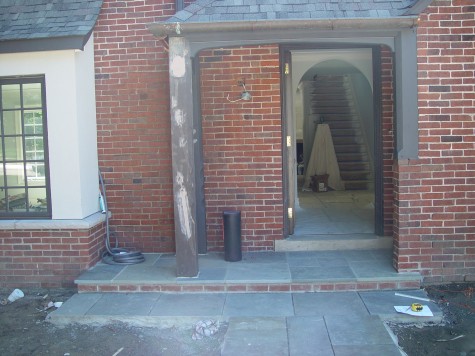 The front porch, originally only inches wider than the front door, was redone. The new porch absorbed an awkward space between the original stoop, and the adjacent bay window. Four years later, with the exception of one stone that is shaling probably from salt damage, the stonework is beautifully intact.
The front porch, originally only inches wider than the front door, was redone. The new porch absorbed an awkward space between the original stoop, and the adjacent bay window. Four years later, with the exception of one stone that is shaling probably from salt damage, the stonework is beautifully intact.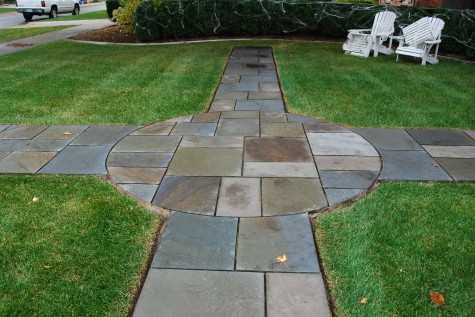 The front walkways from the drive and streetside meet in a circular stone landing midway to the door. Perhaps there will be a sundial someday, or a sculpture, or a high school graduation picture being taken.
The front walkways from the drive and streetside meet in a circular stone landing midway to the door. Perhaps there will be a sundial someday, or a sculpture, or a high school graduation picture being taken.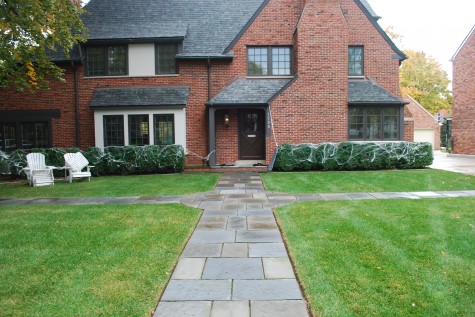
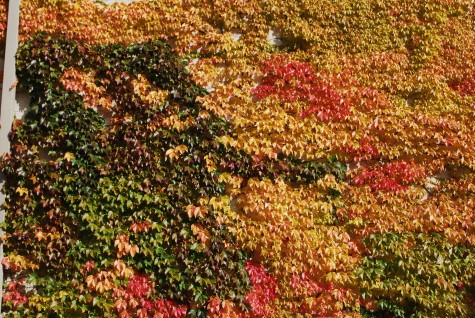 I have never forgotten my ninth grade science teacher, Dr. Watson. He concluded every lecture or discussion with the statement, “And that is the beauty of science”. Though at the time I thought he was a crackpot, I now know he was absolutely right. Today I am thinking about Parthenocissus Tricuspidata; Boston Ivy is an ordinary plant with a fancy scientific name whose primary claim to fame is its ability to grip to and cover walls with dense sheets of leaves. Why today? The fall color of Boston Ivy is one of nature’s most spectacularly glowing moments, ranking right up there with the aurora borealis.
I have never forgotten my ninth grade science teacher, Dr. Watson. He concluded every lecture or discussion with the statement, “And that is the beauty of science”. Though at the time I thought he was a crackpot, I now know he was absolutely right. Today I am thinking about Parthenocissus Tricuspidata; Boston Ivy is an ordinary plant with a fancy scientific name whose primary claim to fame is its ability to grip to and cover walls with dense sheets of leaves. Why today? The fall color of Boston Ivy is one of nature’s most spectacularly glowing moments, ranking right up there with the aurora borealis. 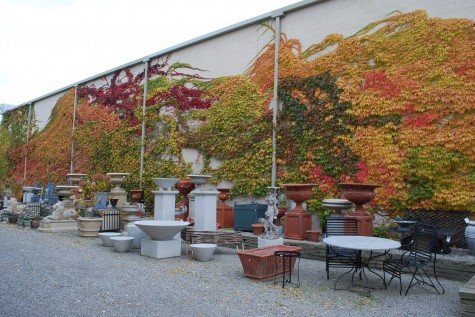 One wall of the building next door to me sits right on my property line; that would be just about two thousand square feet of beige concrete block. Needless to say, I was not too crazy about the look. Five Boston Ivy plants have just about transformed that wall in four years time; today it is looking exceptionally good. The science behind all this color-the formation of the abcission layer. Don’t black out; I’m talking about the beauty of science here. As soon as the nights get long enough in the fall, the cells that connect the leaves to the stems begin to rapidly divide-but they do not expand. This produces a brittle callus, which slows, and finally prevents the flow of nutrients from the stem to the leaves. The plant is going dormant, and putting any expenditure of energy on hold. This is a survival mechanism, the instinct to preserve life, and the beauty of science.
One wall of the building next door to me sits right on my property line; that would be just about two thousand square feet of beige concrete block. Needless to say, I was not too crazy about the look. Five Boston Ivy plants have just about transformed that wall in four years time; today it is looking exceptionally good. The science behind all this color-the formation of the abcission layer. Don’t black out; I’m talking about the beauty of science here. As soon as the nights get long enough in the fall, the cells that connect the leaves to the stems begin to rapidly divide-but they do not expand. This produces a brittle callus, which slows, and finally prevents the flow of nutrients from the stem to the leaves. The plant is going dormant, and putting any expenditure of energy on hold. This is a survival mechanism, the instinct to preserve life, and the beauty of science. 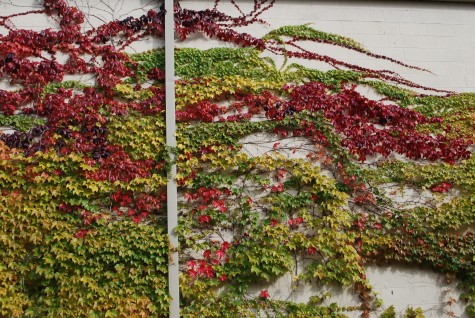 At the same time, the leaves slow down and eventually quit producing chlorophyll-that chemical that makes leaves green. If chlorophyll is not constantly manufactured in a leaf, the leaf will fade in sunlight. Chlorophyll masks the other pigments existing in leaves; the yellows, oranges and reds that were there all along are revealed when the production of chlorophyll ceases.
At the same time, the leaves slow down and eventually quit producing chlorophyll-that chemical that makes leaves green. If chlorophyll is not constantly manufactured in a leaf, the leaf will fade in sunlight. Chlorophyll masks the other pigments existing in leaves; the yellows, oranges and reds that were there all along are revealed when the production of chlorophyll ceases. 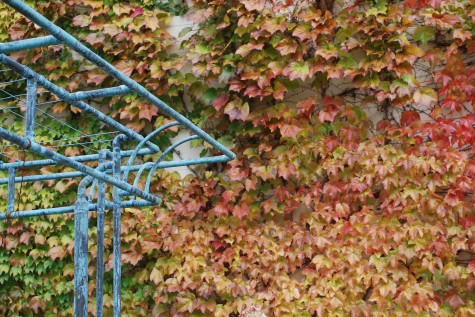 Though day length triggers this process, the temperatures, the moisture in the soil, and sunlight influence the overall show. A dry growing season can encourage leaves to drop early before they reveal any color. High winds can sever the dry corky abscission layer with the same result. At any rate, the variation and intensity of color on this wall is different every year given weather conditions. I can see that light, water, wind, sun and overnight temperatures affect the leaves on wall at different rates.
Though day length triggers this process, the temperatures, the moisture in the soil, and sunlight influence the overall show. A dry growing season can encourage leaves to drop early before they reveal any color. High winds can sever the dry corky abscission layer with the same result. At any rate, the variation and intensity of color on this wall is different every year given weather conditions. I can see that light, water, wind, sun and overnight temperatures affect the leaves on wall at different rates.  It is easy to see the chlorophyll fading at different rates in different leaves-the color variation within each individual leaf is beautiful.
It is easy to see the chlorophyll fading at different rates in different leaves-the color variation within each individual leaf is beautiful.  Anthocyanins are responsible for the red and purple pigments in leaves. They are manufactured from sugars that are trapped in the leaf. Oddly enough, these pigments are not present in leaves during the growing season. The role of these pigments is not so well understood. If you are interested in reading more about it, The United States National Arboretum has an excellent article on line about the science of color in autumn leaves.
Anthocyanins are responsible for the red and purple pigments in leaves. They are manufactured from sugars that are trapped in the leaf. Oddly enough, these pigments are not present in leaves during the growing season. The role of these pigments is not so well understood. If you are interested in reading more about it, The United States National Arboretum has an excellent article on line about the science of color in autumn leaves. Metasequoia Glyptostroboides-I wish this were my name. The Dawn Redwood is an ancient evergreen tree with a twist; it drops its needles in the fall, after turning this glorious peachy orange. This deciduous evergreen is an anomaly amongst evergreens, which ordinarily hold their foliage all winter.
Metasequoia Glyptostroboides-I wish this were my name. The Dawn Redwood is an ancient evergreen tree with a twist; it drops its needles in the fall, after turning this glorious peachy orange. This deciduous evergreen is an anomaly amongst evergreens, which ordinarily hold their foliage all winter. 